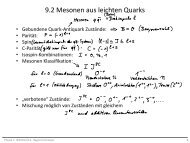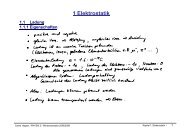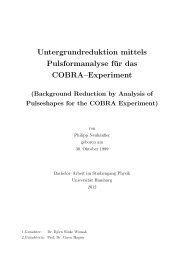Setup of a Drift Tube Muon Tracker and Calibration of Muon ...
Setup of a Drift Tube Muon Tracker and Calibration of Muon ...
Setup of a Drift Tube Muon Tracker and Calibration of Muon ...
Create successful ePaper yourself
Turn your PDF publications into a flip-book with our unique Google optimized e-Paper software.
Distance d between CMT <strong>and</strong> BX-GL TracksInumber <strong>of</strong> entries [per 0.2m]14121086hi_delta_glEntries 125Mean 2.603RMS 2.445χ2/ ndf 19.58 / 34Norm 9.807 ± 1.765Mean 0.5211 ± 0.0651σ 0.3288 ± 0.0684Offset 1.527 ± 0.2234200 1 2 3 4 5 6 7 8 9 10d I[m]Figure 5.25: Distances d I between the impact parameter as reconstructed by theCMT <strong>and</strong> the BX global tracking. A distinct peak can be seen around 0.5m. Thiscorresponds to the average distance <strong>of</strong> the tracks <strong>and</strong> gives a measure for the lateralresolution. Furthermore, a constant <strong>of</strong>fset can be seen, which originates from falsereconstructed tracks r<strong>and</strong>omly distributed. The distribution has been fitted with aGaussian plus a constant <strong>of</strong>fset.interact with the surrounding rock <strong>of</strong> the Gran Sasso massive producing muons.Thus it can occur that such a rock muon is created in the rock in front <strong>of</strong> the Borexinodetector <strong>and</strong> then passes both Borexino <strong>and</strong> OPERA. OPERA reconstructs thesetracks with a high precision [58]. These tracks can also be used to test the Borexinomuon reconstruction.The OPERA PT 3 uses the drift tube technology described in Section 3.1. Dueto its setup it is only capable <strong>of</strong> reconstructing 2D tracks. However, the OPERAdetector is made out <strong>of</strong> more than just the PT. Together with information fromRPCs 4 <strong>and</strong> a target tracker based on plastic scintillator strips, a 3D track is reconstructed.For a detailed description <strong>of</strong> the OPERA detector <strong>and</strong> the 2D trackreconstruction see [58,79]. One major requirement to reduce background in OPERAis an exact time synchronization with the CNGS. CNGS neutrinos are not producedcontinuously, but rather in bunches at discrete times. By knowing the exact timinginformation it is possible to apply a cut on on-time events thus reducing mostbackground. Conveniently, the CNGS “OnTimeStamp” is also distributed to theBorexino DAQ.For a combined analysis all reconstructed on-time tracks that entered the OPERAdetector from either the front or side have been extracted from the OPERA data.This has been done for the 2008, 2009 <strong>and</strong> the beginning <strong>of</strong> the 2010 runs. A collection<strong>of</strong> CNGS on-time events could be easily extracted also from the Borexinodata. Events from both detectors were then matched by the timestamp informationsimilar to the CMT events. Altogether 2291 common events were found.For the combined analysis all track information was transferred into the Borexino3 PT Precision <strong>Tracker</strong>4 RPC resistive plate chamber92





